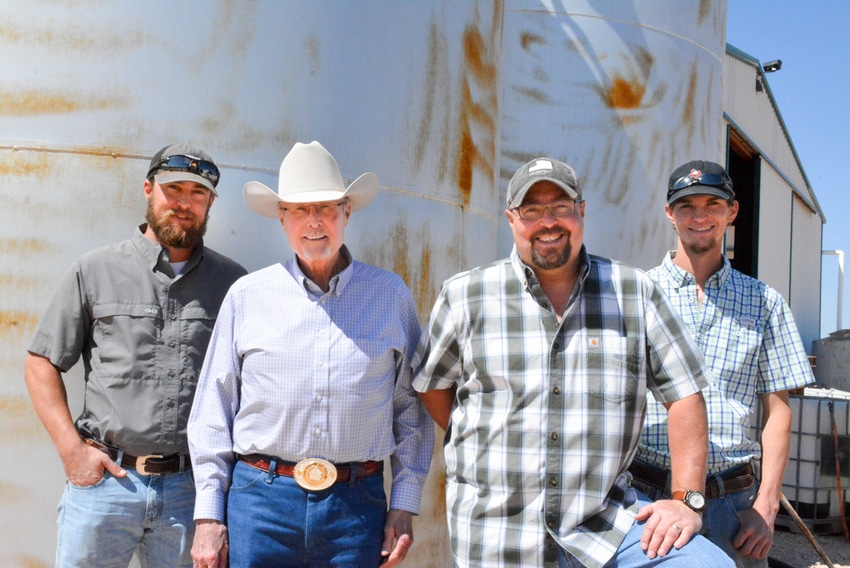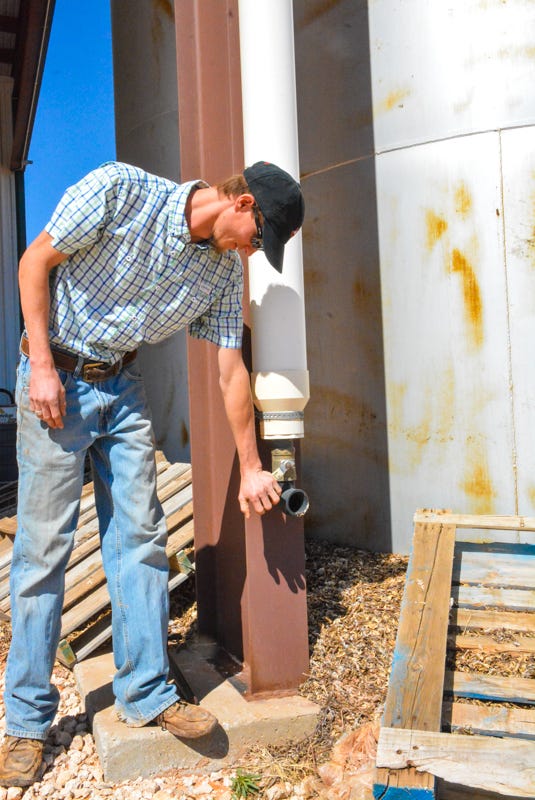
In Terry County, Texas, grower Glen Martin says water is the most limiting factor when it comes to producing peanuts, cotton, wheat and cattle on the family farm. So, when Glen and his father James, and sons Aaron and Kirk, decided to build a 19,000-square foot barn in 2016, rather than only depend on the underground Ogallala Aquifer to supply their water, they installed a rainwater catchment system around the roof of the barn.
"In our part of the world, water is a limited resource. It's a precious commodity," says Aaron Martin. "The well we drilled at the barn, there's not very much water there, we can only pump 2.5 gallons per minute, so with this system we're not having to use that water."
The rainfall is stored in two tanks which hold up to 30,000 gallons of water. It takes a 2.5-inch rain to fill the tanks to capacity. Aaron, who is responsible for the spray side of their operation, uses the water to mix with the chemicals in his spray rig.
In 2018, after making multiple trips across their acres, Aaron used 150,000 gallons of reserved rainwater to spray about 18,000 acres, he says.

"We can't spray all of our acres with that rainwater, it's just not enough. If we got timely rains, we could make it work but at least we're not pumping it all out of the ground," he says.
This year, they've received more than 13 inches of rainfall and collected about 126,400 gallons of rainwater. But due to a June 17 hail storm that destroyed 3,500 acres of cotton and therefore reduced the number of acres needed to be sprayed, Aaron says he's only used 80,000 gallons of water.
The Martins also use the stored rainwater to wash their vehicles and equipment in the barn's wash bay, which also includes a drain where the used water is piped down the hill to a lower area. Aaron says because the rainwater is pure it doesn't leave sediment spots on their windows or the body of the vehicles like well-water does.
COST-SHARE
The Martin's rainwater harvester is a cost-share project between the Martins and the South Plains Underground Water Conservation District (SPUWCD) and the Terry County Soil & Water Conservation District. Glen, who had been looking for an alternate water source for the barn, learned about the project while serving on the TCSWCD board.
"Our goal is to conserve water but also to get people to think outside the box about ways to get their water rather than only pulling it out of the ground," says Layne Marlow, SPUWCD field technician.

While SPUWCD has several rainwater harvesting projects, the Martin's is the first of this magnitude.
The design includes 420 feet of 6-inch PVC pipe that runs under the gutters around the roof of the barn. Rainwater runs into the gutters, then into the PVC pipe which in turn runs into a PVC downspout with a valve. "You keep that valve closed and the first rain that comes off of the roof will fill that pipe up and that's your filter system," describes Glen. "All the nasty, dirty stuff that comes off first goes into that downspout. And then once it's full, it flows over into the tank and fills the tank.
"And we know the downspout works because the first time we opened it, the guys who built the barn had left a box of screws on top, so the first time we flushed it out, all of the screws came out, along with bugs and other stuff."
The project also includes about 240 feet of 2-inch and 3-inch PVC underground pipe, tying together the tanks along with the wash rack, Marlow reports.
Looking ahead, Aaron says he would like to increase the storing capacity of their unit. "With our rainfall, we usually get big rains all at once rather than consistent rains throughout the season. We just need more capacity because it will fill up and then we're overflowing. Right now, we have 30,000 gallons of capacity. I really think we could have another 20,000 or 30,000 and fill them up."
And while everyone involved in the project admits a rainwater harvester of this size isn't cheap, Marlow says the benefits can outweigh the cost down the road.
For more information about this project or others, go to https://spuwcd.org.
About the Author(s)
You May Also Like






